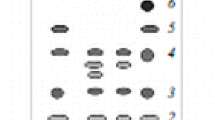Summary
Highly impure residues obtained from an extract of alkalinized tissues can be purified by dissolving the residue in 5 ml of sulphuric acid (pH 5) and heating the solution on water bath with 0.1 g ninhydrin and 1.5 ml pyridine for one hour.
The reaction products are acidified (pH 1–2) with sulphuric acid and washed with ethyl acetate (2×30 ml). The washed aqueous phase is alkalinized and extracted with chloroformbutanol (9:1) (1×40 ml). The chloroform layer is washed with water (2×2 ml), filtered and evaporated to give a residue suitable for chromatographic analysis.
This purification procedure was applied to aliquots of an extract of putrefied tissues to which known amounts of atropine, brucine, caffeine, strychnine, heroin, hyoscine, morphine and quinine were added. Good recoveries were obtained (71–100%) when the added amount was over 1 mg. Fair recoveries were obtained with amounts in the range of 1 to 0.1 mg, except for atropine, hyoscine and quinine which gave low recoveries (15–30%).
For general application, the ninhydrin purification procedure must follow a previous ether extraction in basic medium to save the sympathicomimetic amines and some labile alkaloids.
Zusammenfassung
Besonders unreine Rückstände von alkalischen Gewebsextrakten können dadurch gereinigt werden, daß der Rückstand in 5 ml Säure (pH 5) aufgenommen wird und die Lösung auf dem Wasserbad mit 0,1 g Ninhydrin und 1,5 ml Pyridin für I Std erhitzt wird. Das Reaktionsgemisch wird mit Schwefelsäure angesäuert (pH 1–2) und zweimal mit 30 ml Äthylacetat gewaschen. Die wäßrige Phase wird alkalisch gemacht und mit 40 ml Chloroform-Butanol-Gemisch (9:1) extrahiert. Die Chloroform-Phase wird zweimal mit 2 ml Wasser gewaschen, filtriert und für die chromatographische Analyse eingedampft.
Dieses Reinigungsverfahren wurde für Extrakte von fauligem Gewebsmaterial verwendet, dem bekannte Mengen an Atropin, Brucin, Coffein, Strychnin, Heroin, Hyoscin, Morphin und Chinin zugesetzt worden waren. Gute Ausbeuten (71–100%) wurden bei über 1 mg zugesetzter Substanzmenge, leidliche Ausbeuten bei 0,1–1 mg erzielt, mit Ausnahme von Atropin, Hyoscin und Chinin, die nur in geringer Ausbeute (15–30%) gewonnen werden konnten.
Für die allgemeine Anwendung empfiehlt es sich, das Ninhydrin-Reinigungsverfahren an eine vorherige Ätherextraktion aus alkalischem Medium anzuschließen, um sympathikomimetische Amine und einige labile Alkaloide zu schonen.
Similar content being viewed by others
Bibliography
Gonzales, T. A., Morgan, V., Helpern, M., Umberger, C. J.: Legal medicine, pathology and toxicology, 2nd ed., p. 1139. New York: Appleton Century Crofts, Inc. 1954.
Daubney, C. G., Nickols, L. C.: An investigation into the methods of toxicological analysis of viscera. Analyst 62, 851–859 (1937).
Geagley, W. C., Ohmen, H. G.: Potassium iodoplatinate as a locating agent in paper chromatography. Proceedings of the 10th Assoc. Offic. Racing Chemists Meeting, Appendix XV, 1956.
Ludy-Tenger, F.: Mikrochemische Identitätsreaktionen auf Nikotinamid und Nikotinsäure. Mikrochim. Acta 38, 460–465 (1951).
Smith, I.: Chromatographic and electrophoretic techniques. Chromatography, vol. I. London: William Heinemann Medical Books, Ltd. 1960.
Bastos, M. L.: Unpublished work.
Gettler, A. O., Sunshine, I.: Colorimetric determinations of alkaloids in tissues by means og methyl orange. Analyt. Chem. 23, 779 (1951).
Conn, R. B., Davis, R. B.: Green fluorescence of guanidinium compounds with ninhydrin. Nature (Lond.) 183, 1053–1055 (1969).
Yamagishi, M., Yoshida, T.: Ninhydrin reaction of secondary amines. Pharm. Soc. Japan 74, 1042–1044 (1954).
Mosbascher, R., Ibrahin, M.: Indene derivatives. IV. Synthesis of bis-1,3-diceto indanylideno and experiment with ninhydrin (triketo indanhydrate). J. chem. Soc. 702, 3 (1949).
Yamagishi, M., Hoshida, T.: Ninhydrin reaction of diamines. Pharm. Soc. Japan 74, 1075–1077 (1954).
Jepson, J. B., Stevens, B. J.: A fluorescence test for serotonin and other triptamines. Nature (Lond.) 172, 772 (1953).
Yamagishi, M., Yoshida, T.: Role of hydrindantin in ninhrydin reaction. Pharm. Soc. Japan 74, 1004–1008 (1954).
Schilling, E. D., Burchill, P. I., Clayton, R. A.: Anomalous reaction of ninhydrin. Analyt. Biochem. 5, 1–6 (1963).
Author information
Authors and Affiliations
Additional information
Presented to the Fifth International Meeting of Forensic Sciences, Toronto — June 1969.
Laboratory for Addective Drugs, 520 First Avenue, New York, N. Y. 10016.
Rights and permissions
About this article
Cite this article
Bastos, M.L. Use of ninhydrin to purify extracts of putrefied biological specimens. Z Rechtsmed 67, 57–63 (1970). https://doi.org/10.1007/BF00200426
Received:
Issue Date:
DOI: https://doi.org/10.1007/BF00200426



